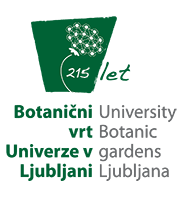Svetlana Makarovič
risbe / Drawings, 2014
originalna risba / Original drawing : 32 x 24 cm
reprodukcija v knjigi / Reproduction in the book : 17 x 11.6 cm
barvna kreda, strukturiran papir / Chalk crayons on textured paper
Zbirka pesmi Zeliščarka je izšla v kategoriji Slovensko leposlovje, Poezija pri založbi Beletrina, 2014
The collection of poems "The Herbalist" was published in the category Slovenian Fiction - Poetry by Beletrina Publishing House in 2014
oblikovanje / Design by Maja Licul
Originalne ilustracije narejene za zbirko poezij prikazujejo motive iz narave; rastline, cvetlice, drevesa, trave, trnje, gobe, jagodičevje, travnike in močvirja, vode in tleč pepel. Kompozicijsko je motiv postavljen centralno včasih malo iz centra, lahko se podvaja, se grupira ali prekriva ……
Te risbe ustvarjene v brezbarvni paleti, z dodanimi značilnimi akcenti, preveva neverjetna harmonija. Mehko ozadje povezuje risbo, odsotnost moteče barve pa poudari glavni motiv, upodobljen le v rjavih odtenkih z dodano črno in belo. Ta minimalističen pristop k risbi ustvari iluzijo, da rastline in deli dreves preprosto vznikajo iz bogate, taktilne podlage. Povezanost med podlago in narisanimi predmeti ustvarja iluzijo globine in nakazuje raze odnose. Včasih je predmet narisan z močnimi linijami; različna kakovost črte, ki je lahko izrazita, nalomljena ali prekinjena podobo obogati z nabojem aktivnosti ali pa v njej ustvari posebno razpoloženje. Ostri oziroma mehki robovi predmetov ne podajajo risbi zgolj formalni estetski učinek temveč ustvarjajo tudi čustveni naboj. Umetničine poteze, poudarjeni detajli, sila ustvarjalnega pritiska na podlago in prelivanje različnih tekstur kažejo na zelo premišljeno obdelavo nosilca risbe.
Zdi se kot jesen, umirjena in zamišljena čeprav so rastline še polne življenja in sokov. Vitalizem je lahko tudi temačen; ukvarjanje z zelišči in strupenimi rastlinami lahko povzroči halucinacije, razširi zavest, odpre vrata v nerealne svetove…. , morda celo pelje v smrt. Ko beremo njene pesmi, lahko razumemo umetničino potrebo po eliminaciji barve, kot tudi njen taktilni način uporabe ustvarjalnega medija.
Ko se podobe in besedilo v knjigi znajdejo ene nasproti drugih, to ustvari določen občutek intimnosti, žalosti in grenkobe ali pa morasto tišino zasidrano v transcendentalnem vizualnem kraljestvu. To niso botanične risbe, niti skice za herbarij. Šele po branju pesmi lahko posamezne slike razumemo kot simbole – metafore specifičnih mentalnih in čustvenih sanj. Vidimo jih kot prikaz človeških odnosov, bolečine, ljubezni, izgube, krivde celo umora, zla in smrti. Lahko pa vzbudijo v nas tudi občutek nedolžnosti, polsna in sna ali prikličejo spomine. Umetničin umirjen in vzvišen vizualni jezik je prežet z nadrealizmom. Navsezadnje lahko te risbe razumemo kot ilustracijo življenja, ki v svoji samoti vztraja ob tem kompliciranem, razklanem človeštvu. Le vseprisotna narava s svojimi rjavimi odtenki, črno-belimi akcenti, in nežno spreminjajočimi se finimi teksturami, kjer se vse med seboj preliva in spreminja, ima smisel.
The original drawings made for a collection of poems bring forth motifs from nature: plants, flowers, trees, grasses, thorns, mushrooms, berries, meadows and marshlands, waters and burning ashes. The compositions are built by placing the motif in the centre, or slightly off centre or by coupling, grouping and overlapping it and sometimes as close-ups. An incredible harmony permeates all the drawings which are made in a colourless pallet with distinctive markings. A soft background unifies the image while the main motif is highlighted by the lack of distracting colours and is drawn only in various shades of brown with the addition of black and white. In this minimalist drawing approach plants and details of trees seem to emerge from a rich tactile space. The connection between the objects and their background indicates to us various relationships and creates an illusion of depth. Sometimes the object is depicted in a strong outline. Through a different quality of line – solid, broken, interrupted – the image becomes charged with action or a specific mood is being created. The sharp or smooth edges of the object don’t render the image just a formal aesthetic quality but also an emotional charge. The artist’s strokes, the highlighted areas, the amount of expressive pressure applied while drawing and the blending in of various textures all suggest a very careful manipulation of the surface.
It almost feels like autumn, calm and pensive, although the plants are still teeming with life and their juices are flowing. Vitalism may also have a dark side; handling medicinal herbs or toxic plants could cause hallucinations, seeing more... or beyond reality, or it could even lead to death. However when reading her poems, we can understand the artist’s choice of not using colours as well as her tactile use of the medium. Images and words placed vis-à-vis in a book can create a sense of intimacy, sadness and bitterness and a nightmarish quietness anchored in a transcendental visual realm. These are not botanical drawings nor sketches for a herbarium collection. Only after having read the poems, one could embrace individual images as symbols – metaphors for specific emotional or mental states, see them as a depiction of human relationships, of pain and love, of loss, guilt or even of murder, evil and death. However, they could also evoke feelings of innocence, of dreamlike states, of sleep as well as memories. This calm and dignified visual language is permeated with surrealism. Consequently these images might be seen as an illustration of life still persevering in its solitude in the midst of the complex and broken humankind. What makes sense is the omnipresent nature with its warm earthly tones enriched through a white and black accent and a soft shifting of a fine texture while everything is merging one into another and transforming itself.
tekst Ina Širca
prevod Nina zelenko












